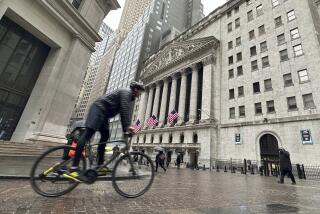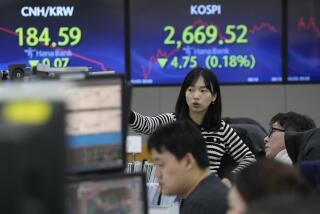High anxiety for 401(k) investors
Like many Americans, Steve Kriegsfeld has been watching his life savings bounce up and down each time the stock market takes a dramatic turn.
Lately, it’s the drops that have grabbed his attention. In just one day last week, the Dow Jones industrial average plunged 465 points before partially recovering. It is down nearly 6% since Jan. 1.
“Does it concern me when it goes down? Yes,” said Kriegsfeld, a 61-year-old Phoenix resident who started stashing away money for retirement when he was in his 30s.
The insurance agent makes it clear he is not “ready to jump out the window” when his portfolio takes a hit. But he pays close attention.His nest egg has grown significantly over the years, and the time he will need it draws closer every day.
Once, “The thought was ‘My gosh, it will never grow to where it will ever be able to support me,’ ” he recalled. “But as I grew older and saw it grow, I thought, ‘Now I need to really protect this.’ ”
As Americans increasingly link their well-being to financial markets, the possibility of recession and a slump on Wall Street has taken on new meaning for the middle class, including baby boomers who are approaching retirement age.
Some 50 million workers now participate in 401(k)-type savings plans, a number that has shot up since 2000 as employers increasingly stop offering traditional pensions.
Similarly, 46 million households hold a stake in the tax-advantaged savings plans known as individual retirement accounts, according to the Investment Company Institute.
The result is a historic linkage between the fortunes of the public and Wall Street, just as older baby boomers -- now past 60 -- focus more seriously on the living standards that await in their post-work years.
“You’ve been saving all these years,” said Pamela Hess, director of retirement research at Hewitt Associates. “You’ve got quite a big nest egg, potentially. The stakes are just so much higher when you’re that much closer to retirement.”
The market has fallen hard in the last several months as the sub-prime mortgage crisis and credit crunch have threatened to send the economy into a tailspin.
The Dow Jones industrial average is down 11.9% from its all-time high last Oct. 9. The Nasdaq composite index has tumbled 17.5% from its recent peak and was briefly down more than 20% last week, the threshold generally considered to be a bear market.
In perspective, it is also true that half the workforce remains uncovered by any retirement plan, a gap that is starting to draw attention in Congress and the presidential campaign. And many workers have only modest savings accounts.
However, for millions of workers in medium and large companies, the reality is that retirement benefits increasingly are skewed toward personal investments. That shift puts added pressure on individuals to try to take care of themselves, rather than rely on a traditional pension, and it raises the stakes of wrong decisions.
“There’s a real vein of anxiety” when the market swings wildly as it did last week, noted Margaret H. Smith, a financial planner who teaches economics and finance at Claremont McKenna College.
But she added that older workers and retirees should not shortchange their life expectancy. Many will be around for decades, increasing the chances that even people in their 60s and 70s could recover their stock losses over time.
“If you only expect to live five to 10 more years, maybe you should cut your losses and get out [of stocks] -- because the market could go down more,” Smith said. “But barring that, I’d say it’s pretty costly to get out. . . . If they miss the subsequent upswing, then in a way they hurt themselves even more.”
Nevertheless, it can take several years for indexes to recoup their bear market losses.
For example, it took the Dow almost seven years to revisit its January 2000 peak after the dot-com bubble burst.
From 2000 to 2006, the number of workers participating in 401(k) plans rocketed from 39.8 million to 49.5 million, according to the Investment Company Institute. Further, employers anticipate a continued rise as they implement “automatic enrollment” programs in response to a 2006 pension law that clarified the legality of such strategies.
The growing emphasis on 401(k) plans remains controversial, and their rewards remain uneven.
Among workers in their 50s, for example, the average 401(k) balance in 2006 was $138,160, said Hewitt Associates, which keeps tabs on a set of medium-size and large employers. Some have much more.
Among workers 55 and up, 17% have nest eggs of $500,000 or more, according to a survey last year by the Employee Benefit Research Institute; 28% estimate their overall retirement assets at over $250,000.
Despite the emergence of a relatively small group of “401(k) millionaires,” most workers fall somewhat lower on the wealth ladder, including Kriegsfeld.
Kriegsfeld declined to disclose the value of his portfolio or details of his holdings. In general terms, he said he aimed to protect his nest egg by spreading his money around in a “well-rounded” assortment of mutual funds that invest primarily in shares of large, established companies.
He does not try to outguess professional investors or outmaneuver the market. “I don’t know of too many working Americans who have time to keep up with that stuff,” he said. “We don’t go for a big killing.”
Instead, he tries to keep a steady course. “I know there are bumps in the road, and I’ve ridden them out,” he said.
Most financial advisors agree with that advice. They recommend that people diversify their holdings by investing in mutual funds of stocks and bonds, and gradually weighting that balance toward the less volatile bond funds and cash as they near retirement.
Nonetheless, when savings face pressure, some workers and retirees feel compelled to take decisive action.
Just before the stock market tanked in 2000, Nancy Haynes was anticipating a future free of financial worry. On a canoe ride in the Pocono Mountains of Pennsylvania, she and her husband counted up all their assets, including their home, and concluded that they might be worth $1 million.
But the sharp decline of technology and other stocks slashed about one-third of their nest egg’s value, and Haynes began to worry.
At 65, the retired human resources professional went back to work.
“Was it to pay the bills?” she asked. No -- it was to ease her financial anxiety. “It was to not have to worry about money all the time.”
Many other older workers apparently took a similar course, perhaps foreshadowing that baby boomers might stay in the workforce in the case of a future downturn. An analysis by Boston College found an unusual increase in the rate of work among Americans ages 55 to 64 after the 2000 crash.
“It’s suggesting that people who have experienced a clear-cut hit to their portfolio are more likely to work longer,” said Andrew D. Eschtruth, an author of the study.
Given the public’s growing dependence on 401(k) accounts, a deep or prolonged downturn in the markets could have a broad societal effect, said Jack VanDerhei, a retirement specialist at Temple University. In addition to people returning to the workforce or postponing retirement, many more Americans would have to scale back their lifestyles than in the past, he said.
A ripple effect could hit the workplace, as younger employees wait longer for anticipated promotions because their older counterparts hung around longer.
“Without a doubt -- comparing where we are today with 401(k) plans as the primary form of retirement savings for many baby boomers -- the impact of a down equity market has a much bigger impact on society than when traditional pensions were the primary form of retirement income,” VanDerhei said.
Haynes, now 71 and retired once again, is following the latest financial gyrations with concern. “It makes me more worried now, because I’m older,” said Haynes, whose nest egg of several hundred thousand dollars includes a 401(k) and the lump sum she received from a separate pension plan.
The New Jersey resident, whose mother is 95, expressed what may be the bottom line for older investors who want to preserve their savings in a time of increasing longevity -- and an increasing cost of living.
“I don’t want to outlive my money,” she said.
jonathan.peterson
@latimes.com






